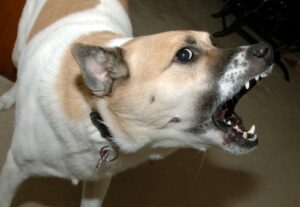Barks Blog
Managing an Aggressive, Fearful, or Reactive Dog
By Don Hanson

When you have a dog that is exhibiting aggressive behavior, you have a responsibility to keep yourself, your family, your pets, and your community safe.
A dog that is behaving aggressively is experiencing some form of emotional stress, so it is your responsibility to identify and keep him away from the stressors that trigger the behavior while working with a professionals who can help you.
#1. Get Help from an Accredited Professional as Soon as Possible
Helping change aggressive behavior is not a Do-It-Yourself project, nor is a dog likely to “grow out of it.”
Aggression is an emotional response. That response could be due to fear, anger, or frustration and may be intensified by chemical imbalances in the brain.
Working with a dog trainer and teaching behaviors like sit, leave it, stay etc. are extremely unlikely to change how your dog feels.
As such, I recommend you immediately seek help from a veterinary behaviorist, applied animal behaviorist, or credentialed behavior consultant (PCBC or CDBC). The earlier you get professional help for your dog, the sooner you can relieve his suffering and the greater probability you have of changing his aggressive behavior.
Resolving this behavior will very likely require behavior modification and, potentially, medication as well. A veterinary behaviorist can provide you with both.
#2. Ensure Safety
Preventing your dog from hurting you, another person, another animal, or themselves must be your priority.
• Please keep your dog physically isolated from people or animals that could become the target of his aggression.
This may mean keeping him crated, preferably in another room, or closed/locked in another room when you have guests in your home.
• When the dog is outside of your home, make sure that you can safely handle him. When he is outside of your home and in an unfenced area, he should be on a regular 6ft.-leash.
Please do not use a Flexi or retractable leash, as they do not provide adequate control. The leash should be securely attached to a front-connect harness.
• Consider using a muzzle if you can do so safely. It is essential to gently condition your dog to wear a muzzle before using it. Seek the advice of a trained professional in helping you accomplish this task (see Resources).
Muzzles can be a useful management tool. However, in my experience:
1) a determined dog can get out of any muzzle;
2) putting on the muzzle can cause the dog stress;
3) muzzling your dog and having him around others can be tantamount to advertising that you have an aggressive dog and, thus, may change the people’s behavior which can cause a reaction by the dog;
4) a muzzle may make the dog more fearful;
5) A muzzle can limit your dog’s ability to breathe correctly, causing additional distress. A muzzle is, at best, a temporary solution and does nothing to address the source of the dog’s behavior or his emotional state.
• Do NOT leave your dog outside, unattended. Being tied-out can be very stressful to a dog and can be a frequent cause of fear aggression.
When a dog is tied up, he knows he cannot flee or fight, which are both typical reactions a dog would pursue if afraid. Even if you have a fenced yard, I recommend you remain with your dog whenever he is in the yard, as no fence can be guaranteed to be 100% secure.
• If your dog does not need to go with you, leave him at home. A dog that is reactive while in the car can be a threat to your safety and that of others. If he becomes reactive wherever you take him, you may make yourself unwelcome, and you are probably making him more likely to react in the future too.

#3. Prevent the Behavior from Getting Worse
• This is a given but I will mention it anyway. Refrain from using any training and management tools that have the potential to cause your dog distress, discomfort, or pain.
• Avoid placing your dog in situations where there is a potential for him to display the behavior of concern. Preventing him from acting aggressively is essential to ending this behavior.
Each time the dog has the chance to engage in the behavior, it can make it more likely to occur again and to increase in intensity. Events like this can affect the chemistry and anatomy of the brain, making future reactions more likely.
• Limit movement when your dog reacts. Activity can increase arousal, and this can increase the probability of aggression and reactivity.
If your dog is barking and running back and forth from window to window, either in your home, in the yard, or in the car, try to restrict movement either with a crate, a leash, or, if in the car, a seat belt.
• Carefully consider safety issues and the possibility of making your dog’s behavior worse if you walk him away from home.
If you cannot walk your dog safely or if you continue to expose him to his triggers, you are better off staying at home. If you do take him for walks, choose locations and times when you are least likely to encounter his triggers.
When walking a dog with reactivity/aggression issues, you must be constantly aware of your environment. It is not a time to be daydreaming, thinking about tomorrow’s schedule, chatting on your cell phone, conversing with a friend walking with you, or listening to music.
Alternatively, you can find other ways to provide your dog with physical and mental stimulation, such as playing in the yard and feeding him with a Kong.
• If your dog is aggressive towards people or dogs, you need to keep him away from places where people and dogs congregate. Dogs with aggression issues will not get better if you take them places like pet stores, dog parks, dog events, charitable walks, or any other site where people and dogs gather.
• Prepare people before allowing them to interact with your dog, and do not force your dog to interact. Remember, it is not just your dog’s behavior that will determine the result of a dog/human interaction, but also the actions of the person.
Do your best to teach people that come to your home how to interact with your dog. Providing them with a copy of Dr. Sophia Yin’s How to Greet A Dog (And What to Avoid) handout is an excellent first step (see Resources).
Allow the dog to decide if he wants to interact with people, and if he declines, allow him to do so. You need to be especially prepared if your dog is a breed that some people readily prejudge. If someone is anxious around your dog, it will likely make you and your dog nervous as well.
• Be especially cautious in the following situations:
o Whenever your dog is around large gatherings of people. Large groups are likely to increase his excitement/anxiety/fear/frustration, which increases the probability of an inappropriate response.
o Anytime your dog is around children. Most children do not understand how to behave around dogs. Children and dogs ALWAYS need adult supervision.
• NEVER punish your dog or get angry with him for growling. While a dog’s growl can be upsetting and disheartening to us, it also serves the beneficial purpose of alerting us to the fact that the dog is feeling threatened or uncomfortable.
It is the dog’s way of saying, “If something in this situation does not change, I may feel threatened enough to bite.” If your dog growls, calmly remove him from the situation with as little fanfare and emotion as possible.
• Consider how your emotions and those of others may be affecting your dog. Dogs are very adept at reading the emotions of people through their body language and scent, which may change how he reacts to them and/or you.
Since our emotions are always part of the dog’s environment, any anxiety and frustration we, or others, feel may cause our dog to become more anxious.
If your dog detects someone is angry, it may cause him to become angry or afraid. He will not inherently know why a person is angry or scared, but may react out of self-preservation.
If you are having difficulties with your emotional responses, it may be beneficial for you to seek assistance. Your dog may also benefit from seeing a veterinary behaviorist that can help him temper his emotions.
#4. Reducing Your Dog’s Stress
• Learn how stress affects your dog’s behavior. Stress, either the detrimental kind, distress, or the beneficial type, eustress, is frequently a component in undesirable behavior for people and animals.
Our bodies react very similarly when experiencing distress or eustress, producing hormones and other chemicals that make us more likely to be reactive and irritable. People often think of adverse events or memories of adverse events as being the cause of stress.
However, things our dog enjoys, such as playing fetch, can also cause stress. When something our dog likes is allowed to the extreme, reactive behavior can become more likely.
• Minimize unpredictability and be consistent. Unpredictability in our behavior can be a significant stressor for our dogs. As a family, you all need to commit to working together and using the same training approach with your dog.
Getting a different response from each individual in the home only stresses the dog more. You all need to have consistent expectations, but they do need to be reasonable.
• Work with an accredited professional to consider options for helping reduce your dog’s stress. A veterinary behaviorist may recommend prescription medications and non-prescription products that may help alleviate your dog’s anxiety.
#5. Document Your Dog’s Behavior
• Keep a daily journal. Behavioral issues are seldom straightforward. However, if you keep a detailed journal of what happened and when, your chosen professional will be better equipped to help you help your dog.
A journal has the added benefit of allowing you to see improvements in your dog, which is positive reinforcement for you continuing to follow the program you are using.
#6. Train Your Dog
Training your dog to offer specific behaviors when cued will not necessarily change his emotional state. However, teaching him certain behaviors may make him easier to manage, especially if you can intervene well before he starts reacting to a situation.
Training your dog is also a great way to build and maintain trust, provided you use only rewards and do not use any aversives.
Resources
Dog Training by Kikopup. (2013). Teach your dog to wear a muzzle [Video File]
Hanson, D. (2015). Canine Behavior – Understanding, Identifying and Coping with Canine Stress
Hanson, D. (2015). Canine Behavior – What Should I Do When My Dog Growls?
Hanson, D. (2020). Do I Need a Dog Trainer or a “Behaviorist?”
Pet Professional Guild: Find an Expert
Muzzle Up Project. (n.d.). Muzzle Training
Yin, S. (2011). Preventing Dog Bites by Learning to Greet Dogs Properly
This article was first published in BARKS from the Guild, November 2020, pp.29-31. Read the full article Managing an Aggressive, Fearful, or Reactive Dog.
For more great content on all things animal behavior and training, you can sign up for a lifetime, free of charge, subscription to the digital edition of BARKS from the Guild. If you are already a subscriber, you can view the issue here.
About the Author
Don Hanson is the co‐owner of the Green Acres Kennel Shop in Bangor, Maine. He is a Bach Foundation registered animal practitioner (BFRAP), certified dog behavior consultant (CDBC), associate certified cat behavior consultant (ACCBC) and a certified professional dog trainer (CPDT‐KA) and also produces and co‐hosts a weekly radio show and podcast, The Woof Meow Show on The Pulse AM620 WZON. He writes about pets on his blog and is co‐chairman of PPG’s Advocacy Committee.
